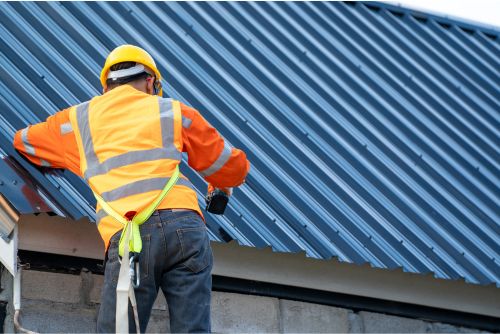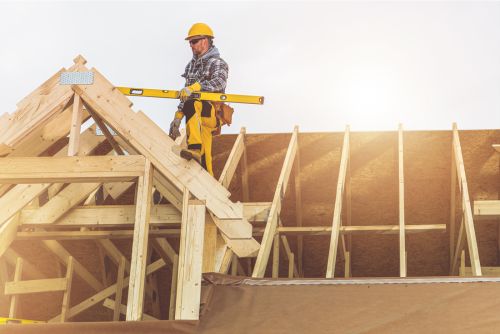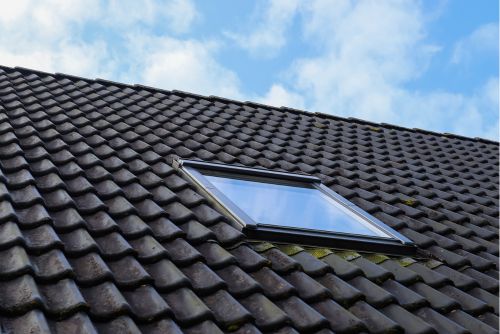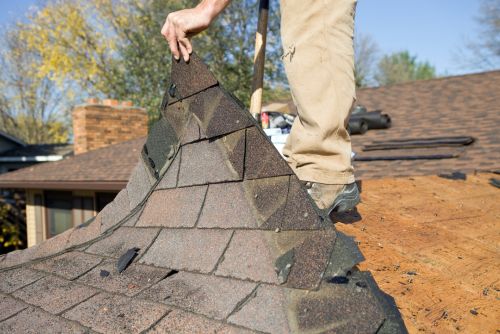Have you ever wondered what is the most expensive part of a new roof?
When it comes to investing in a roofing project, there are several factors that can contribute to the overall cost. From the choice of materials to the size and complexity of the roof, each element plays a crucial role in determining the final price tag. However, there is one particular aspect that often stands out as the most significant expense. Curious to find out?
Stay tuned as we explore the various factors that can impact the cost of a new roof and uncover the most expensive part that might surprise you.
Roofing Materials
Durable roofs start with roofing materials. Roof replacement costs depend on the material used. The market offers many materials with different benefits and costs.
Asphalt shingles are popular roofing materials. Their affordability and versatility are well-known. Asphalt shingles come in many styles and colors, so homeowners can pick one that suits their tastes. Asphalt shingles are affordable to install, making them a good choice for budget-conscious homeowners.
Metal roofing is great if you want innovation and pay for high-quality materials. Metal roofs are durable and energy-efficient. They last up to 50 years and can withstand harsh weather. Metal roofing requires specialized skills to install, so it costs more than asphalt shingles.
Consider clay or concrete tiles for an eco-friendly roof. Durable and well-insulated, these materials reduce energy use and utility bills. Due to their weight and complexity, clay or concrete tiles cost more to install.
Labor Costs

Let’s talk about roof installation labor costs. When calculating labor costs, consider the roofing contractor’s expertise and efficiency. Roof installation labor costs depend on project size, complexity, location, and contractor experience.
Hire a professional roofing contractor for a proper and efficient installation. Their expertise saves time and money over time. An experienced contractor will have the tools and equipment to finish the job quickly but if you want to do it on your own, you need to have the right skills and knowledge.
Installation materials are included in labor costs. The project requires nails, shingles, underlayment, and other materials. These materials vary in price depending on quality and type.
To get the best labor price, get multiple quotes from contractors. Keep in mind that the cheapest option may not be the best. Before choosing a contractor, consider their experience, reputation, and customer reviews.
Roof Size And Complexity
Roof size and complexity greatly affect installation costs. The cost of a new roof depends on its size and complexity. Some things to consider:
- Roof Size: The size of the roof area plays a crucial role in determining the cost. A larger roof area requires more materials and labor, which can drive up the price. Additionally, the shape and pitch of the roof may also impact the overall size and, consequently, the cost. It’s essential to accurately measure the roof area to ensure accurate pricing.
- Complexity: The complexity of a roof refers to its design and structure. Roofs with multiple slopes, valleys, and dormers tend to be more intricate and time-consuming to install. These complexities require additional materials, expertise, and labor, which can increase the cost. Moreover, if the roof has unique features such as skylights or chimneys, it may also add to the complexity and cost of the installation.
- Most Expensive: Among the various factors contributing to the cost of a new roof, the roof size and complexity tend to be the most expensive. Larger roofs require more materials and labor, while complex designs demand specialized expertise. Therefore, it’s crucial to consider these factors when budgeting for a new roof.
Innovative roofing solutions evolve to meet modern architecture. Advanced materials and technologies can optimize cost and installation, offering innovative roof size and complexity solutions. By keeping up with the latest innovations, homeowners can choose a new roof that balances cost and quality.
Type Of Roof (E.G., Flat, Sloped)

A flat or sloped roof greatly affects the cost of a new roof. The type of roof you choose can affect the cost.
Flat roofs cost more than sloped ones. Flat roofs need more materials and labor to drain and prevent water pooling. Flat roof installation requires specialized skills and equipment, which increases cost.
However, sloped roofs are cheaper because they are more common and easier to install. Sloped roofs naturally drain water, so no additional measures are needed. Asphalt shingles and metal are cheaper and more accessible for sloped roofs.
While flat roofs are more expensive upfront, they have benefits. They offer extra space for rooftop gardens or solar panels. Flat roofs are more energy-efficient because they insulate and reduce heat loss.
Underlayment
It’s important to consider the underlayment’s impact on a new roof’s cost and functionality. The roof deck and shingles need underlayment to protect them. Three things to know about underlayment and roof replacement costs and roofing technology innovation:
- Enhanced durability: Advanced underlayment materials, such as synthetic options, offer superior resistance to tears, leaks, and moisture. This added durability ensures a longer lifespan for your roof, reducing the need for frequent repairs or premature replacements.
- Improved energy efficiency: Innovative underlayment options can help increase the energy efficiency of your home. Reflective underlayment, for example, minimizes heat absorption, keeping your home cooler during hot summer months. This can lead to reduced cooling costs and a more comfortable living space.
- Enhanced protection: Underlayment acts as a secondary barrier against water infiltration. It safeguards your roof deck and interior from potential damage caused by leaks or ice dams. Additionally, underlayment provides an extra layer of protection against wind-driven rain and other external elements, ensuring your roof remains structurally sound.
Underlayment type, size, and quality are crucial to the longevity and functionality of your new roof. Underlayment may not be the most expensive part of a new roof, but high-quality materials can reduce damage and repair costs over time.
A professional roofing contractor can recommend the most innovative and effective underlayment for your roofing needs.
Ventilation System

A well-designed and efficient ventilation system is essential for new roof installations to ensure airflow and prevent moisture buildup. Buying a good ventilation system can reduce roof replacement costs. It helps maintain the house’s structural integrity and roof durability.
Roofers know that good ventilation extends roof life. Attics can become overheated and damp without proper ventilation, causing many issues. Heat accelerates roofing material deterioration, necessitating replacement. High humidity can cause mold and mildew growth, which can damage the roof and harm occupants.
A good ventilation system brings fresh air into the attic and removes hot air and moisture. This regulates temperature and humidity, protecting the roof and alleviating the air conditioning load. It also prevents ice dams from forming in the winter, which can cause leaks and water damage.
The installation of a ventilation system requires skilled labor, but the benefits outweigh the cost. An efficient system reduces roof maintenance and repair costs, saving homeowners money over time. By reducing air conditioning use, a well-ventilated roof saves energy.
Flashing And Gutters
The roof needs proper flashing and gutters to prevent water damage and drain properly. Flashing and gutters, the most expensive parts of a new roof, are essential to its integrity. Three reasons why high-quality flashing and gutters are worth it:
- Preventing Water Damage: Flashing serves as a protective barrier against water infiltration in areas where the roof meets walls, chimneys, or skylights. It creates a watertight seal, preventing leaks and potential water damage to the underlying structure. Gutters, on the other hand, collect rainwater and direct it away from the roof, foundation, and landscaping, preventing erosion and water-related issues.
- Ensuring Longevity: By properly channeling water away from the roof, flashing and gutters help extend the lifespan of the roofing materials. Without adequate drainage, water can accumulate and lead to rot, mold, and deterioration of the roof deck and supporting structures. Investing in quality flashing and gutters ensures that your roof stays in optimal condition for many years to come.
- Enhancing Energy Efficiency: Properly installed flashing and gutters help improve the overall energy efficiency of your home. By preventing water intrusion, they reduce the risk of insulation damage and air leaks, which can result in higher heating and cooling costs. Additionally, well-maintained gutters ensure that rainwater doesn’t accumulate on the roof, reducing the chances of ice dams forming during colder months.
Buying high-quality flashing and gutters for a new roof is smart. These essentials prevent water damage, extend roof life, and boost energy efficiency. Proper installation and maintenance can keep your roof in top shape for years. So now you finally know what is the most expensive part of a new roof.
Skylights Or Roof Windows

Homeowners who want to improve their roofs’ appearance and functionality often install skylights or roof windows. Skylights and roof windows can be expensive parts of a new roof. Several factors make them expensive.
Skylights and roof windows vary in price depending on brand, size, and style. Premium features like energy-efficient glass and automated blinds cost more. Installation increases costs. Installing skylights or roof windows requires roof cutting and sealing to prevent leaks. This requires skilled labor and specialized tools, increasing costs.
Location and number of skylights or roof windows also affect the price. Multiple units or hard-to-reach locations may require more labor and materials, increasing costs. The type of roof you have can also affect the cost. Roofs with steep slopes or complex designs may be harder to install, increasing costs.
Insulation
Energy efficiency and thermal comfort on a new roof depend on insulation. Insulation is crucial to roof cost. There are three reasons why insulation matters for roof cost and quality:
- Energy Efficiency: Proper insulation helps to reduce heat transfer, keeping your home cool in the summer and warm in the winter. By minimizing the need for heating and cooling, you can significantly lower your energy bills and save money in the long run.
- Material Longevity: Insulation helps to regulate the temperature and moisture levels in your roof space. This is important because extreme temperature fluctuations and excessive moisture can cause materials to deteriorate more quickly. By providing a stable environment, insulation can help extend the lifespan of your roofing materials, reducing the need for frequent replacements.
- Overall Cost Savings: While insulation may add to the initial cost of a new roof, it can lead to significant savings over time. By reducing energy consumption and extending the life of your roofing materials, insulation can help lower your overall roof cost in the long term.
When replacing a roof, invest in good insulation. Spray foam and rigid foam boards are durable and thermally efficient insulation materials. By choosing the right insulation, you can maximize energy efficiency, extend roof life, and save money on installation and maintenance.
Removal And Disposal Of Old Roof

Old roof removal and disposal are often the most expensive parts of a new roof installation. Labor, equipment, and material costs contribute to this.
Hire professionals with the skills and experience to safely and efficiently remove the old roof. Labor costs depend on roof size, complexity, and location. Removal often requires specialized equipment, which increases cost.
Getting rid of old roof materials is also important. Proper disposal is environmentally friendly and often regulated by local governments. The type and quantity of materials disposed of affect disposal costs.
Materials also add to the cost of removing and disposing of the old roof. The removal of some materials is harder and takes longer, increasing labor costs. The weight and volume of materials disposed of also affect disposal costs.
Innovation in roof removal and disposal focuses on cost-effective and environmentally friendly methods. Some companies are considering using advanced machinery and methods to streamline removal and cut labor costs. Others are exploring ways to recycle and reuse old roof materials to reduce disposal costs and waste.
Permits And Inspections
Permits and inspections are needed before installing a new roof. To ensure project safety and quality, local building codes and regulations are followed during construction. Permits and inspections may seem like a hassle, but they’re essential to the roofing process. New roof permits and inspections are necessary for three reasons:
- Compliance with Building Codes: Building codes are put in place to ensure the structural integrity and safety of buildings. By obtaining the necessary permits, you demonstrate that your new roof meets these codes and regulations. Failure to comply with building codes can result in fines or even the need to redo the entire roof installation.
- Quality Assurance: Inspections play a vital role in ensuring the quality of the roof installation. Certified inspectors will assess the workmanship, materials used, and overall compliance with industry standards. Their expertise and attention to detail can help identify any potential issues before they become costly problems down the line.
- Insurance Coverage: Many insurance companies require proof of permits and inspections when filing a claim related to a new roof. Without proper documentation, you may risk having your claim denied, leaving you financially responsible for any damages or repairs.
Although permits and inspections increase the cost of a new roof, they’re worth it. By following proper procedures, you can avoid legal issues, prolong roof life, and maintain property value.
Additional Features (E.G., Chimneys, Dormers)

Chimneys and dormers should be carefully planned and coordinated to blend into a new roof’s overall design. These features can improve your home’s design and functionality in both ways.
For instance, chimneys can add elegance and charm to your home’s exterior while venting smoke and gases from fireplaces and heating systems. A well-designed and installed chimney can make your home more attractive.
Dormers provide natural light and ventilation while adding living space to the attic. These architectural elements increase usable square footage and add roofline depth and visual interest. Dormers can make a plain roof stand out with their unique shapes and styles.
These extras can raise the cost of a new roof. Their installation complexity, materials, and customization can greatly affect their price. Therefore, you must carefully consider the cost of adding chimneys and dormers to your new roof design.
Warranty And Maintenance
When considering chimneys or dormers for a new roof, homeowners must understand their warranty and maintenance requirements. The warranty for your new roof should specify what’s covered and for how long. A comprehensive home warranty can ease your mind and prevent unexpected costs. Your new roof will last longer and perform better with regular maintenance. Here are three important warranty and maintenance considerations for your new roof:
- Coverage: Before committing to a warranty, carefully review what’s covered. Some warranties may only cover certain types of damage, while others may have exclusions for specific causes. Understanding the warranty coverage will help you know what to expect in terms of repairs or replacements.
- Duration: The length of the warranty is another crucial aspect to consider. Some warranties may only last a few years, while others can extend up to several decades. A longer warranty period provides greater protection and can save you money on future repairs or replacements.
- Maintenance Requirements: To ensure the validity of your warranty, it’s important to adhere to the maintenance requirements specified by the manufacturer. Regular inspections, cleaning, and minor repairs are typically necessary to keep your warranty intact. Following these maintenance guidelines won’t only protect your investment but also help prevent any potential issues from escalating.
Understanding your new roof’s warranty and maintenance requirements will extend its lifespan and prevent costly repairs. Be proactive and maintain your roof to enjoy its benefits for years.
Geographic Location

Your new roof’s considerations and challenges depend on its location. When planning a roofing project, consider your location’s unique characteristics. Climate, weather, and environmental conditions can greatly affect your roofing project’s cost estimate and total cost.
Roofing material innovations allow for a wide range of options designed to withstand different geographic conditions. Impact-resistant shingles or metal roofing may be recommended in hurricane-prone areas to protect against strong gusts. In areas with intense heat or sunlight, reflective roofing materials can lower energy costs by keeping your home cooler.
Your roof material may also depend on your location. To avoid ice dams and water damage in heavy snowfall areas, a steep-sloped roof with snow-shedding materials may be needed. A water-resistant, drainable roofing material is essential in rainy areas.
The availability and cost of roofing materials may vary by location. Remote material transport may increase roofing project costs. In areas with high demand or limited supply, some materials may cost more.
Contractor Expertise And Reputation
A successful roofing project requires a skilled and reliable contractor. The cost and quality of a new roof installation depend on the contractor’s expertise and reputation. Contractor expertise and reputation are crucial to roofing project success for three reasons:
- Quality Workmanship: A contractor with expertise in roofing will have the necessary skills and knowledge to perform the job effectively. They’ll understand the intricacies of different roofing materials, installation techniques, and industry standards. Their expertise ensures that the roof is installed correctly, minimizing the risk of leaks, structural damage, and other costly issues down the line.
- Access to Premium Materials: Reputable contractors often have access to high-quality roofing materials that may not be readily available to the average homeowner. These materials are often more durable, energy-efficient, and aesthetically pleasing. By working with an experienced contractor, you can benefit from their knowledge of premium materials, ensuring that your new roof isn’t only functional but also adds value to your home.
- Long-Term Savings: While hiring an experienced contractor may seem more expensive upfront, it can actually save you money in the long run. A well-installed roof by a reputable contractor is less likely to require frequent repairs or replacement, reducing maintenance costs over time. Additionally, their expertise allows them to identify potential issues early on and address them before they become major problems, saving you from expensive repairs and further damage.
Final Thoughts
What is the most expensive part of a new roof? Based on my research, it’s clear that the most expensive part of a new roof can vary depending on several factors. However, roofing materials and labor costs seem to be the primary contributors to the overall expense.
Other factors such as roof size, complexity, type, underlayment, additional features, warranty, maintenance, geographic location, and contractor expertise also play a role in determining the final cost. Therefore, it’s important to consider these factors when planning for a new roof installation.
Frequently Asked Questions
What Are The Different Types Of Roofing Materials Available?
There are many roofing materials. Asphalt shingles, metal roofing, clay tiles, and slate are common.
Each material has pros and cons, so choose one that fits your needs and budget. Asphalt shingles are the cheapest, while metal roofing is more expensive but durable and energy-efficient. Clay and slate tiles are durable and beautiful, but they are expensive.
How Long Does It Typically Take To Install A New Roof?
The average roof installation takes a few days. Roof size and project complexity affect the duration. Please note that time frames vary. Always consult a professional roofing contractor to assess your needs and provide a more accurate estimate.
Can I Install A Flat Roof On My House Or Do I Need To Choose A Sloped Roof?
I can install a flat roof on my house, but it mightn’t be the most cost-effective option. Flat roofs require specialized materials and installation techniques, which can drive up the overall cost.
Additionally, flat roofs are more prone to water pooling and leaks, which can lead to costly repairs down the line. It’s important to weigh the benefits and drawbacks of both flat and sloped roofs before making a decision.
Do I Need To Replace The Underlayment When Installing A New Roof?
When installing a new roof, it’s important to consider whether the underlayment needs to be replaced. The underlayment acts as a protective barrier against moisture and helps to extend the lifespan of the roof.
While it may add to the overall cost of the project, replacing the underlayment is a worthwhile investment in ensuring the longevity and durability of your new roof. It’s always best to consult with a professional roofer to determine the specific needs of your roof.
Are There Any Additional Costs Associated With Installing Skylights Or Roof Windows?
Installing skylights or roof windows may cost more. These features can improve a new roof’s appearance and functionality.
Skylight or window type, size, and installation complexity can affect cost. These factors should be considered when planning a new roof to stay within budget.

